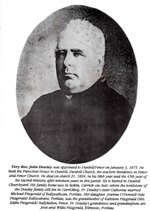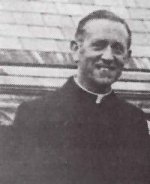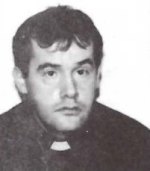Fenor 1996 – Diary of a Parish Community
“Fr. Stephen Remembers”
by Fr. Stephen O’Brien C.C.
On All Souls’ Day [November 2nd, 1996] I was passing Fenor Church but something drew me in. As I picked my way nimbly through the fading light and headstones into the small porch, kneeling alone in the front pew in the dark church with only one small red flicker of light, memories of faces and places began to flood back through me, of my five years among the people of Fenor.
On a bright September morning in 1981 I was told that my first appointment was to a parish called Dunhill and Fenor. The latter name I simply associated with Annestown cliffs where my father had camped in a bell-tent during the war years, cycling each day to work in Waterford. After fourteen years in college institutional life I was glad to have my own house at last, even if it could fit two families. Many people enquired if I had felt this change very traumatic but I honestly did not, perhaps because I wanted to move out of college anyhow and because I retained my teaching connection with the college, three days a week during my first year. This gradually lessened as I became involved more in parish life.
My first initiation into the new ‘parish life’ saw me sitting on a tiny yellow chair at my first Sale of Work Committee meeting one Monday October night in the school hall. I vividly remember spending the night busy stapling what seemed like thousands of tickets together in threes and wondering to myself whether this was the pinnacle of my pastoral involvement! Little did I realise the story of commitment and dedication that I was to be a part of for a few years which culminated each first Sunday of December and which was the focus for so much community activity. Another early memory finds me perplexed, standing perishing, with my knees knocking, in a windswept circus tent, attempting to pull a winning ticket out of a huge drum and wishing I was back with my books. I never won anything in all the subsequent Sales and often committed the sin of jealousy when the parish priest invariably headed off with something, even if it was only a cuddly bear.
All of this great effort was in aid of Fenor School which I soon learned was the centre of community life. Some of my fondest memories are set in that bright place and I could fill pages with joyful reminiscences. I choose simply to remember our first Christmas School Concert. Having just welcomed everyone and introduced the singing angels, and struggling with a plainly over-full schedule, I darted to Dunhill Church to help celebrate a Reconciliation service. Then straight back to Fenor breathless, I arrived just in time to walk out and nonchalantly thank all and sundry for coming out to our concert, only to be told by a small voice after my few words that, ‘Father, you said exactly the same thing as the new Master said just before you’. So much for powers of bilocation.
Christmas and Easter are the high points of liturgical celebration and Fenor Church lends itself so well to the intimacy of such key moments of the year. The thrill of watching the darkened church come alight as tiny flames crept from pew to pew until, finally, the whole gathering is one bright place, will never grow stale for me.
First Communion and Confirmation are also very special moments and I learned to marvel at the extraordinary way small boys and girls today take to using a hand-held microphone and tell their part of the story with consummate confidence. But it also gave me a little sense of how parents must feel when, almost overnight, these same wide-eyed six-year-olds are suddenly Confirmation candidates and heading into those awkward teenage years.
Of course, the staple diet of births, marriages and deaths are the daily bread of parish work. I remember especially the baptisms we were lucky to have at the Easter Vigil, a real live bouncing baby could hardly be surpassed as a symbol of new life and new growth in any parish. Fenor Church lends itself especially well to marriages, the intimacy of the place adding to the joy of a young couple and their families celebrating the beginning of a new parish family.
But it was with the rituals surrounding the end of life’s journey that many of my most vivid memories of Fenor lie. Sadly there were many such ritual-times over the last five years as we said goodbye to dear friends, young and old alike. Never before had I experienced the extraordinary solidarity of a small rural community as it united time and time again to support a grief-stricken family with age-old customs of quiet kindness and compassion. Before the sad news was barely hours old those mountains of sandwiches and home baking would be quietly arriving from the neighbours, tangible tokens of comfort. I can honestly say that the most personally fulfilling aspect for me of being a priest is the great privilege it affords to be allowed to enter that sacred space of family life in times of sad loss and partings when life is stripped back to the bone and we struggle to comfort one another from the well of our Christian faith and hope in Jesus. The soft soil of Fenor graveyard holds too many of those I knew to ever forget their memory and I recalled each one that All Souls’ Day recently as I walked and prayed among their marking stones.
But thankfully there were also many joyful times and the celebrations to mark one hundred years of beautiful Fenor church was certainly the highpoint of these for me. Again, so many vivid memories flood in, but I still remember my unutterable joy when a priest friend arrived into the sacristy a quarter of an hour before the Mass with a big old suitcase full of white vestments, one for each priest in the audience. It was the icing on the cake and indeed I felt that the Lord was truly smiling on us. I certainly won’t ever forget that Mass and the glorious night (and morning) of music and dancing under that huge white and green marquee: ni beidh a leithead ann aris. Nor will I lose my huge admiration for all the many people, and especially the key few, who did such Trojan work to make those days in Fenor such halcyon ones.
On a sunny evening in mid-June last, I arrived back to my big house to find an unexpected voice on my new answering machine. It was that of my bishop! Since that day I have begun to come to terms with a new life and the challenge of a huge urban parish. I am still at the stage of putting up new curtains and making new friends. I am so grateful to the Lord that my first experience of parish was with the communities of Fenor and Dunhill, with Fr. Gerard Purcell as parish priest. And as I gave thanks in Fenor Church that evening recently, I remembered all my friends with gratitude and felt happy that an important part of my life lies in those wooden pews, red stones and kind hearts in Fenor near the sea.





